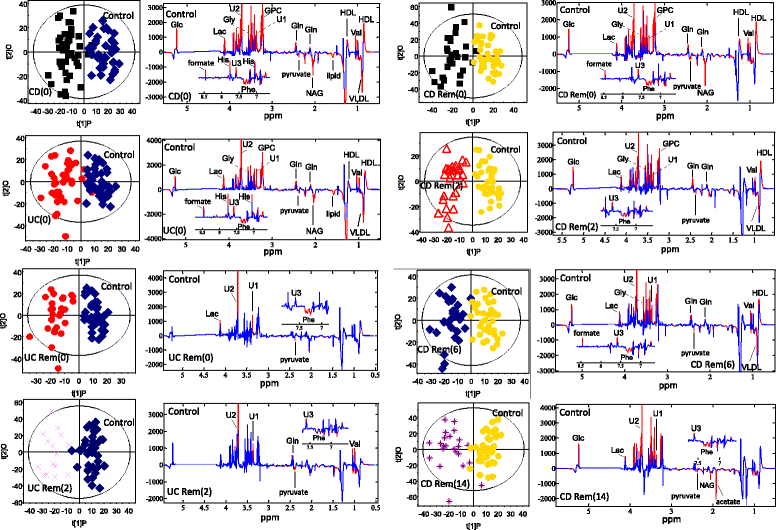Metabonomics uncovers a reversible proatherogenic lipid profile during infliximab therapy of inflammatory bowel disease
- PMID: 29032767
- PMCID: PMC5641999
- DOI: 10.1186/s12916-017-0949-7
Metabonomics uncovers a reversible proatherogenic lipid profile during infliximab therapy of inflammatory bowel disease
Abstract
Background: One-third of inflammatory bowel disease (IBD) patients show no response to infliximab (IFX) induction therapy, and approximately half of patients responding become unresponsive over time. Thus, identification of potential treatment response biomarkers are of great clinical significance. This study employs spectroscopy-based metabolic profiling of serum from patients with IBD treated with IFX and healthy subjects (1) to substantiate the use of spectroscopy as a semi-invasive diagnostic tool, (2) to identify potential biomarkers of treatment response and (3) to characterise the metabolic changes during management of patients with tumour necrosis factor-α inhibitors.
Methods: Successive serum samples collected during IFX induction treatment (weeks 0, 2, 6 and 14) from 87 IBD patients and 37 controls were analysed by 1H nuclear magnetic resonance (NMR) spectroscopy. Data were analysed with principal components analysis and orthogonal projection to latent structures discriminant analysis using SIMCA-P+ v12 and MATLAB.
Results: Metabolic profiles were significantly different between active ulcerative colitis and controls, active Crohn's disease and controls, and quiescent Crohn's disease and controls. Metabolites holding differential power belonged primarily to lipids and phospholipids with proatherogenic characteristics and metabolites in the pyruvate metabolism, suggestive of an intense inflammation-driven energy demand. IBD patients not responding to IFX were identified as a potentially distinct group based on their metabolic profile, although no applicable response biomarkers could be singled out in the current setting.
Conclusion: 1H NMR spectroscopy of serum samples is a powerful semi-invasive diagnostic tool in flaring IBD. With its use, we provide unique insights into the metabolic changes taking place during induction treatment with IFX. Of distinct clinical relevance is the identification of a reversible proatherogenic lipid profile in IBD patients with active disease, which partially explains the increased risk of cardiovascular disease associated with IBD.
Keywords: Crohn’s disease; Diagnostics; Metabolomics; Serum; Ulcerative colitis.
Conflict of interest statement
Ethics approval and consent to participate
All patients participated in this study in confirmation with the principles outlined in the Declaration of Helsinki and with the approval of the Scientific Ethics Committee of the Copenhagen Capital Region (H-D-2009-055).
Consent for publication
Not applicable.
Competing interests
During the last 2 years, C. Steenholdt has served as a speaker for Abbvie, Pfizer and MSD, and as a consultant for Pfizer and Takeda Pharmaceuticals. The remaining authors have no competing interests to disclose.
Publisher's Note
Springer Nature remains neutral with regard to jurisdictional claims in published maps and institutional affiliations.
Figures



References
-
- Cleynen I, Boucher G, Jostins L, Schumm LP, Zeissig S, Ahmad T, Andersen V, Andrews JM, Annese V, Brand S, et al. Inherited determinants of Crohn's disease and ulcerative colitis phenotypes: a genetic association study. Lancet. 2016;387:156–67. doi: 10.1016/S0140-6736(15)00465-1. - DOI - PMC - PubMed
-
- Geboes K, Colombel J-F, Greenstein A, Jewell DP, Sandborn WJ, Vatn MH, Warren B, Riddell RH, Pathology Task Force of the International Organization of Inflammatory Bowel Diseases Indeterminate colitis: a review of the concept--what's in a name? Inflamm Bowel Dis. 2008;14:850–57. doi: 10.1002/ibd.20361. - DOI - PubMed
MeSH terms
Substances
LinkOut - more resources
Full Text Sources
Other Literature Sources
Medical

